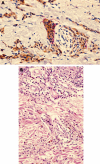The use of LYVE-1 antibody for detecting lymphatic involvement in patients with malignant melanoma of known sentinel node status
- PMID: 15976338
- PMCID: PMC1770724
- DOI: 10.1136/jcp.2004.020123
The use of LYVE-1 antibody for detecting lymphatic involvement in patients with malignant melanoma of known sentinel node status
Abstract
Background: Sentinel node (SN) status is the most important prognostic indicator in patients with cutaneous melanoma without clinically evident metastatic spread, but the procedure is associated with considerable morbidity. The LYVE-1 lymphatic marker offers the possibility of studying lymphangiogenesis and tumour metastasis within the primary excision.
Aims: To establish whether lymphatic vessel numbers/distribution within the primary tumour correlated with SN status. To assess whether tumour cells were easily demonstrable within lymphatics and could be used as a surrogate for SN status.
Methods: Double immunostaining for LYVE-1 and S100 in cutaneous biopsies from 18 SN+ patients with no lymphatic/vascular involvement on routine histology and 18 SN- patients matched for tumour thickness and ulceration.
Results: Lymphatic vessels were detected in all cases. Vessels within the tumour mass were suggestive of active lymphangiogenesis; those outside were mainly mature vessels with well defined walls. Tumour cells within lymphatics were detected in one of 18 SN- and five of 18 SN+ patients. Lymphatics containing tumour cells were all outside the tumour mass in well formed vessels, suggesting melanoma cell invasion into preformed lymphatics. There was no significant difference in lymphatic counts between SN+ and SN- patients. Although peritumorous lymphatic counts were higher in ulcerated than non-ulcerated melanomas, they did not vary with Breslow thickness.
Conclusion: LYVE-1 staining can reliably demonstrate lymphatic vessel distribution, but lymphatic counts cannot predict melanoma metastatic potential and cannot substitute for SN biopsy. LYVE-1 immunostaining can detect melanoma cells within lymphatics, but is unreliable in predicting melanoma metastasis, failing to detect metastatic spread in more than two thirds of patients with regional node metastasis.
Figures








Similar articles
-
Lymphatic invasion detected by D2-40/S-100 dual immunohistochemistry does not predict sentinel lymph node status in melanoma.J Am Acad Dermatol. 2009 Nov;61(5):819-28. doi: 10.1016/j.jaad.2009.04.026. J Am Acad Dermatol. 2009. PMID: 19836642
-
Tumour lymphangiogenesis is a possible predictor of sentinel lymph node status in cutaneous melanoma: a case-control study.J Clin Pathol. 2006 Feb;59(2):166-73. doi: 10.1136/jcp.2005.028431. J Clin Pathol. 2006. PMID: 16443733 Free PMC article.
-
Lymphatic invasion identified by monoclonal antibody D2-40, younger age, and ulceration: predictors of sentinel lymph node involvement in primary cutaneous melanoma.Arch Dermatol. 2008 Apr;144(4):462-7. doi: 10.1001/archderm.144.4.462. Arch Dermatol. 2008. PMID: 18427039
-
Tumor lymphangiogenesis and melanoma metastasis.J Cell Physiol. 2008 Aug;216(2):347-54. doi: 10.1002/jcp.21494. J Cell Physiol. 2008. PMID: 18481261 Review.
-
Update on lymphatic mapping and sentinel node biopsy in the management of patients with melanocytic tumours.Pathology. 2004 Oct;36(5):478-84. doi: 10.1080/00313020412331282726. Pathology. 2004. PMID: 15370119 Review.
Cited by
-
Clinical relevance of detection of lymphovascular invasion in primary melanoma using endothelial markers D2-40 and CD34.Am J Surg Pathol. 2011 Oct;35(10):1441-9. doi: 10.1097/PAS.0b013e31822573f5. Am J Surg Pathol. 2011. PMID: 21881483 Free PMC article.
-
Lymphatic invasion as a prognostic biomarker in primary cutaneous melanoma.Methods Mol Biol. 2014;1102:275-86. doi: 10.1007/978-1-62703-727-3_15. Methods Mol Biol. 2014. PMID: 24258984 Free PMC article.
-
Lymphatic Vessels, Inflammation, and Immunity in Skin Cancer.Cancer Discov. 2016 Jan;6(1):22-35. doi: 10.1158/2159-8290.CD-15-0023. Epub 2015 Nov 9. Cancer Discov. 2016. PMID: 26552413 Free PMC article. Review.
-
VEGFC Gene Expression Is Associated with Tumor Progression and Disease-Free Survival in Cutaneous Squamous Cell Carcinoma.Int J Mol Sci. 2023 Dec 27;25(1):379. doi: 10.3390/ijms25010379. Int J Mol Sci. 2023. PMID: 38203550 Free PMC article.
-
Ulcerated Cutaneous Melanoma: A Review of the Clinical, Histologic, and Molecular Features Associated with a Clinically Aggressive Histologic Phenotype.Clin Cosmet Investig Dermatol. 2022 Aug 30;15:1743-1757. doi: 10.2147/CCID.S372287. eCollection 2022. Clin Cosmet Investig Dermatol. 2022. PMID: 36065342 Free PMC article. Review.
References
-
- Gerschenwald J, Thompson W, Mansfield P, et al. Multi-institutional melanoma lymphatic mapping experience: the prognostic value of sentinel node status in 612 stage I and II melanoma patients. J Clin Oncol 1999;3:976–83. - PubMed
-
- Wagner J, Corbett L, Myung Park H, et al. Sentinel lymph node biopsy for melanoma. Experience with 234 consecutive procedures. Plast Reconst Surg 2000;105:1956–66. - PubMed
-
- Landi G, Polverelli M, Moscatelli G, et al. Sentinel lymph node biopsy in patients with primary cutaneous melanoma; study of 455 cases. J Eur Acad Dermatol Venereol 2000;14:35–45. - PubMed
-
- Shivers S, Xang X, Li W, et al. Molecular staging of malignant melanoma. JAMA 1998;280:1410–15. - PubMed
-
- Blaheta H-J, Ellwanger U, Schittek B, et al. Examination of regional lymph nodes by sentinel node biopsy and molecular analysis provides new staging facilities in primary cutaneous melanoma. J Invest Dermatol 2000;14:637–42. - PubMed
MeSH terms
Substances
LinkOut - more resources
Full Text Sources
Medical
Miscellaneous
